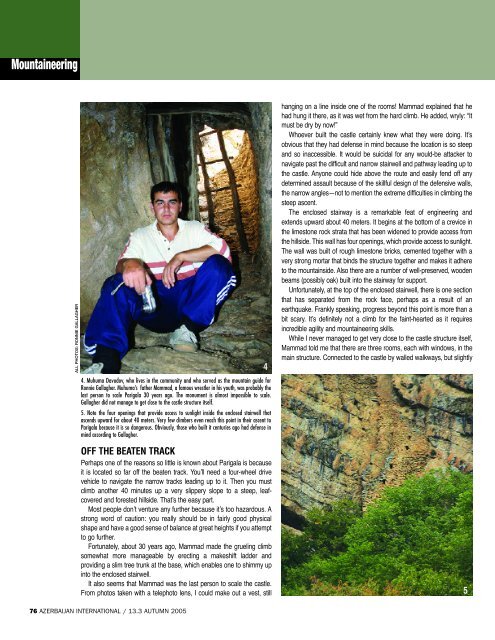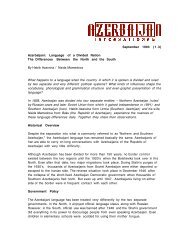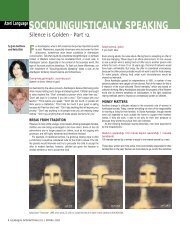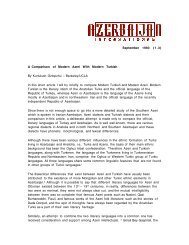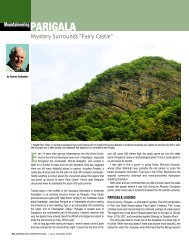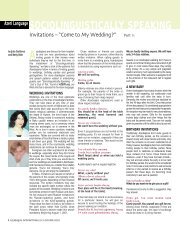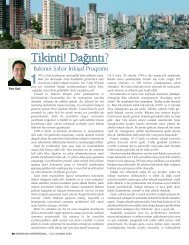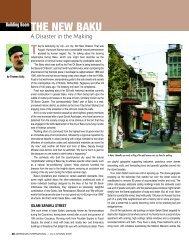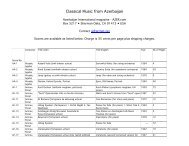Gallagher_Parigala, Azerbaijan - Azerbaijan International Magazine
Gallagher_Parigala, Azerbaijan - Azerbaijan International Magazine
Gallagher_Parigala, Azerbaijan - Azerbaijan International Magazine
Create successful ePaper yourself
Turn your PDF publications into a flip-book with our unique Google optimized e-Paper software.
Mountaineering<br />
ALL PHOTOS: RONNIE GALLAGHER<br />
4. Muhuma Davudov, who lives in the community and who served as the mountain guide for<br />
Ronnie <strong>Gallagher</strong>. Muhuma’s father Mammad, a famous wrestler in his youth, was probably the<br />
last person to scale <strong>Parigala</strong> 30 years ago. The monument is almost impossible to scale.<br />
<strong>Gallagher</strong> did not manage to get close to the castle structure itself.<br />
5. Note the four openings that provide access to sunlight inside the enclosed stairwell that<br />
ascends upward for about 40 meters. Very few climbers even reach this point in their ascent to<br />
<strong>Parigala</strong> because it is so dangerous. Obviously, those who built it centuries ago had defense in<br />
mind according to <strong>Gallagher</strong>.<br />
OFF THE BEATEN TRACK<br />
Perhaps one of the reasons so little is known about <strong>Parigala</strong> is because<br />
it is located so far off the beaten track. You’ll need a four-wheel drive<br />
vehicle to navigate the narrow tracks leading up to it. Then you must<br />
climb another 40 minutes up a very slippery slope to a steep, leafcovered<br />
and forested hillside. That’s the easy part.<br />
Most people don’t venture any further because it’s too hazardous. A<br />
strong word of caution: you really should be in fairly good physical<br />
shape and have a good sense of balance at great heights if you attempt<br />
to go further.<br />
Fortunately, about 30 years ago, Mammad made the grueling climb<br />
somewhat more manageable by erecting a makeshift ladder and<br />
providing a slim tree trunk at the base, which enables one to shimmy up<br />
into the enclosed stairwell.<br />
It also seems that Mammad was the last person to scale the castle.<br />
From photos taken with a telephoto lens, I could make out a vest, still<br />
76 AZERBAIJAN INTERNATIONAL / 13.3 AUTUMN 2005<br />
4<br />
hanging on a line inside one of the rooms! Mammad explained that he<br />
had hung it there, as it was wet from the hard climb. He added, wryly: “It<br />
must be dry by now!”<br />
Whoever built the castle certainly knew what they were doing. It’s<br />
obvious that they had defense in mind because the location is so steep<br />
and so inaccessible. It would be suicidal for any would-be attacker to<br />
navigate past the difficult and narrow stairwell and pathway leading up to<br />
the castle. Anyone could hide above the route and easily fend off any<br />
determined assault because of the skillful design of the defensive walls,<br />
the narrow angles—not to mention the extreme difficulties in climbing the<br />
steep ascent.<br />
The enclosed stairway is a remarkable feat of engineering and<br />
extends upward about 40 meters. It begins at the bottom of a crevice in<br />
the limestone rock strata that has been widened to provide access from<br />
the hillside. This wall has four openings, which provide access to sunlight.<br />
The wall was built of rough limestone bricks, cemented together with a<br />
very strong mortar that binds the structure together and makes it adhere<br />
to the mountainside. Also there are a number of well-preserved, wooden<br />
beams (possibly oak) built into the stairway for support.<br />
Unfortunately, at the top of the enclosed stairwell, there is one section<br />
that has separated from the rock face, perhaps as a result of an<br />
earthquake. Frankly speaking, progress beyond this point is more than a<br />
bit scary. It’s definitely not a climb for the faint-hearted as it requires<br />
incredible agility and mountaineering skills.<br />
While I never managed to get very close to the castle structure itself,<br />
Mammad told me that there are three rooms, each with windows, in the<br />
main structure. Connected to the castle by walled walkways, but slightly<br />
5
6. Close up view of <strong>Parigala</strong>, which obviously served for defensive purposes but may have served religious purposes as well.<br />
7. An archway built into the ascent path up to <strong>Parigala</strong>. In the past 30 years, only one person—Mahmud Davudov—has been known to scale the cliff face and reach the structure itself.<br />
8. Example of the very strong mortar used in the “castle” construction. The mortar binds so well that it was used to affix the tunnel to the rock face of the mountain.<br />
9. Entrance to the tunnel with its 40 meter ascent. There are four openings along the stairs that allow sunlight to permeate the dark tunnel.<br />
10. An example of one of the wooden beams (possibly oak) which provides support for the stairway. The wooden beams could provide ample clue as to the age of the monument. The wood could be dated, using radiocarbon<br />
dating or dendrochronology, a technique that examines the growth of tree ring patterns in relationship to known climactic conditions.<br />
more difficult to see, is a separate structure with two<br />
additional rooms. From the photographs taken from<br />
below, this structure appears to have been<br />
strengthened by the support of retaining walls and<br />
transverse stone blocks.<br />
Overall, the castle has been remarkably well<br />
constructed and preserved over the centuries. It<br />
shows evidence of being occupied for many years<br />
from the polished nature of the limestone rock, which<br />
leads to the entrance stairwell. With the exception of<br />
some damage to the stairwell walls, <strong>Parigala</strong> has<br />
weathered the passing of years surprisingly well with<br />
very little damage.<br />
With proper archaeological study and research,<br />
surely it would be possible to coax out many of the<br />
castle’s secrets. This would be beneficial both the<br />
<strong>Azerbaijan</strong>i people as well as a contribution to the<br />
Search at AZER.com<br />
1. Caucasian Albanian period. Discovery and Decipherment of the<br />
Caucasian Albanian Alphabet by Dr. Zaza Alexidze. Six major<br />
articles in <strong>Azerbaijan</strong> <strong>International</strong>, AI 11.3 (Autumn 2003).<br />
2. Cart Ruts and Stone Circles: Key Evidence from the Past Is<br />
Endangered by Abbas Islamov and Ronnie <strong>Gallagher</strong>. AI 10.3<br />
(Autumn 2002).<br />
3. Early Man in <strong>Azerbaijan</strong>: When Ancient Stones Speak by Ronnie<br />
<strong>Gallagher</strong> and Abbas Islamov. AI 11.1 (Spring 2003).<br />
4. Mud Volcanoes: Mysterious Phenomena Fascinate Scientists and<br />
Tourists by Ronnie <strong>Gallagher</strong>. AI 11.2 (Summer 2003).<br />
AZER.COM<br />
7 8 9<br />
10<br />
world heritage. Indeed, this site could be of significant<br />
historical value for <strong>Azerbaijan</strong>. Studying it might serve<br />
to fill in some gaps related to its pre-Islamic past.<br />
The obvious questions to investigate include: Who<br />
built it? When? Why? And why was it abandoned? For<br />
now, the answers are only speculative. The age of the<br />
castle should be easy to determine since there are<br />
wooden beams built into the walls. The wood could be<br />
dated, using radiocarbon dating or dendrochronology,<br />
a technique that examines the growth of tree ring<br />
patterns in relationship to known climatic conditions.<br />
Determining the structure’s age would be the first step<br />
in placing it into its proper contextual time frame. This<br />
should enable historians and archeologists to be able<br />
to reconstruct some of its history from known events.<br />
Historically, most significant structures are built<br />
either for military or religious purposes. Given the<br />
small size of <strong>Parigala</strong>, it is obvious that only a limited<br />
number of people could survive there, especially since<br />
there doesn’t seem to be a natural source of water. On<br />
the other hand, it could be that the castle had limited<br />
strategic value and that it served a religious function.<br />
While it may be fascinating to think about a maiden<br />
seeking refuge there; it’s more likely that the shelter<br />
served as some sort of monastery for monks or priests<br />
during the early Christian centuries when persecutions<br />
were prevalent and protection so vital—just like many<br />
of the mountaintop monastery retreats in Europe.<br />
Muhuma mentioned that a university archaeologist<br />
had visited the site earlier this year and had taken an<br />
interest in studying it. This is good news. I hope<br />
<strong>Azerbaijan</strong>i authorities will consider actively sponsoring<br />
this site, for its intrinsic value to determine its history and<br />
for the possibility of developing it into a significant tourist<br />
attraction. Providing safe access ways could be built<br />
that do not detract from the appearance and beauty of<br />
the site from below. This would enable another<br />
important archaeological site to become accessible to<br />
those interested in <strong>Azerbaijan</strong>’s past.<br />
<strong>Parigala</strong> is certainly a fascinating and inspiring site.<br />
It deserves further study. I, for one, look forward to<br />
exploring it again, even more closely, next year.<br />
Ronnie <strong>Gallagher</strong> worked as Environmental Manager<br />
for BP in <strong>Azerbaijan</strong> from 2000-2003. During his free<br />
time, he explored much of the countryside, enjoying<br />
the natural history and searching for evidence of<br />
ancient settlements. His observations on stone<br />
circles, cup marks and cart ruts, have been published<br />
in earlier issues of <strong>Azerbaijan</strong> <strong>International</strong>. Ronnie is<br />
currently on assignment in Angola but returns to<br />
<strong>Azerbaijan</strong> whenever possible. Contact Ronnie<br />
<strong>Gallagher</strong>: gallagher_ronnie@yahoo.co.uk.<br />
See also Perigala in the Trailblazer series:<br />
“<strong>Azerbaijan</strong> with Excursions to Georgia” by Mark Elliott.<br />
Third Edition, pp. 221 and 225. ISBN: 1-873756-79 8.<br />
Trailblazer Publications: Surrey, UK, June 2004. See<br />
TRAILBLAZER-guides.com. ■<br />
13.3 AUTUMN 2005 / AZERBAIJAN INTERNATIONAL 77<br />
6<br />
ALL PHOTOS: RONNIE GALLAGHER


